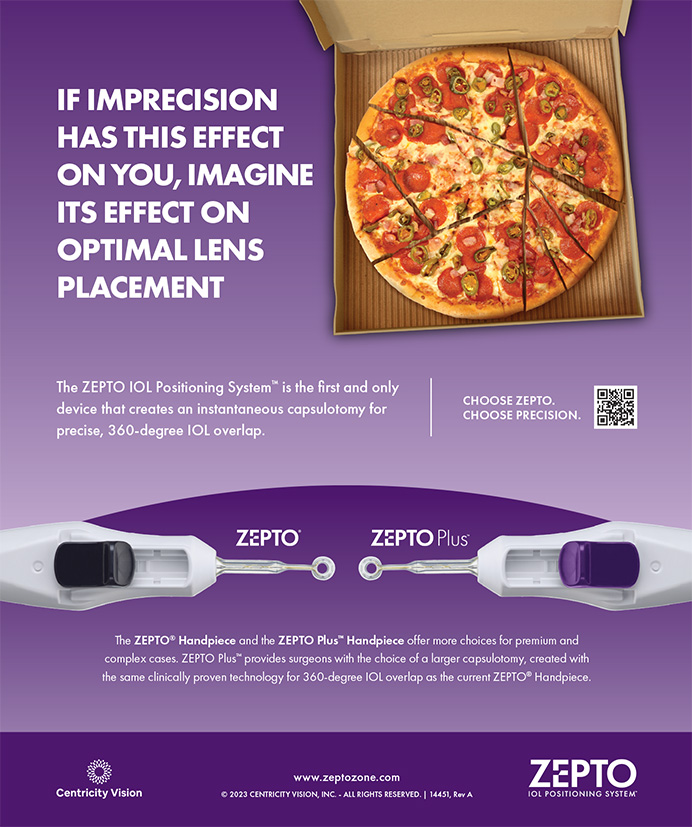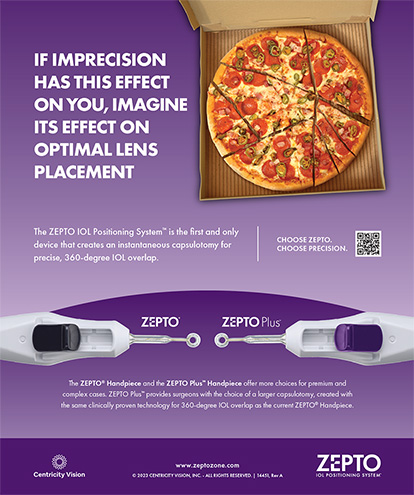The capsulorhexis is one of the most difficult steps of phacoemulsification to learn.1 Competence in this area is critical to safe and efficient cataract surgery.2 I think that learning to create the capsulorhexis has three important components. Residents must (1) visualize a "perfect capsulorhexis," (2) learn to control instruments in the anterior chamber in three dimensions, and (3) learn to control the capsular tear. Although residents can gain knowledge of some aspects of the procedure without practicing on patients, ultimately capsulorhexis creation is best learned in the OR. This article describes how my colleagues and I teach our capsulorhexis technique at the University of Iowa in Iowa City (Figure 1).
CAPSULORHEXIS VISUALIZATION
Books, as well as articles like those in this issue, are helpful vehicles for residents to envisage the ideal capsulorhexis. I think one of the best methods to aid in residents' visualization of a perfect capsulorhexis, however, is through their viewing of related videos. If the residents are exposed to various teachers who use different techniques, a video for each style is most useful. Teaching surgeons should make these types of videos readily available to residents via such means as a server, DVD, or one of the popular video Web sites. I prefer to place important teaching videos on eyepodvideo.org and Google video, as they are free and our residents can easily search them.
WET LAB PRACTICE
A wet lab is an important part of the training process to allow residents to gain control of instruments in the anterior chamber. Two of my colleagues, Emily Greenlee, MD, and Andrew Lee, MD, have developed a formal process at the University of Iowa to guide our residents through their wet-lab training.3 Wet-lab training is most useful to residents when dedicated resources are available and accessible all year. This access allows "just-in-time education" so that those residents who are about to perform capsulorhexis or another step in the procedure can practice just before they are called into the OR.2 Our experience with once-a-year wet labs is that the residents who are months away from their surgical rotation gain very little from the experience.
We prefer to use the pig eye as a model in our wet lab, because it is large, but not so big that residents cannot use the same instruments that they will use on humans. Residents can practice using instruments in the anterior chamber of pig eyes and develop coordination in 3D with these instruments under the microscope. Learning to guide instruments in space under the microscope is an important part of the capsulorhexis. Developing this skill takes time and practice, which is best done out of the OR. Although the porcine anterior chamber is larger than that of a human's, it does help residents to develop a sense of working within a confined space.
The porcine anterior capsule is more elastic than the senile human capsule.4 Trypan blue can be used to stiffen the pig capsule in addition to helping residents with visualization of the tear.5 Our experience, however, is that trypan blue is not enough, and the capsule is still too elastic. Tim Johnson, MD, PhD, from our institution, has developed a solution (based on experience of other groups6-8) using equal parts of formaldehyde and Viscoat (Alcon Laboratories, Inc., Fort Worth, TX) and a few drops of trypan blue, which when placed on the porcine capsule, markedly stiffens it to better simulate the adult human capsule. Using this solution with the porcine capsule is a reasonable, but not perfect, simulation of the human capsulotomy. Figure 2 shows a resident performing a porcine capsulotomy with this solution in the wet lab.
"BACKING INTO CASES"
I think that "backing into cases" is a great technique to safely gain control over instruments in the anterior chamber.2 This technique was developed by Mark Wolken, MD, who is currently in private practice in Anderson SC, when he was a resident at our institution years ago. With this technique, we have the attending or senior resident handle the first part of the case. Then, the more junior resident will "back" his way into the case. For example, in the first week, the junior resident will simply remove the ophthalmic viscosurgical device (OVD) at the end of the case. The next week, he will insert the IOL and remove the OVD. The following week, he might remove some easily accessed cortical material, insert the IOL, and remove the OVD. This method allows the resident to gain experience using the instrument in the eye to perform the less critical portions of the case. Our typical resident would complete approximately 10 "back" portions of the case before attempting a more critical capsulorhexis.
THE LEARNING CURVE
After the resident has "backed" into several cases and developed skills in the wet lab, he is ready to perform his first capsulorhexis in the OR. Faculty should staff all resident cases, but these first few should be reserved for your most experienced teachers. Just as our residents have a learning curve, so do our teachers. Sandra Cremer, MD, and Bonnie Henderson, MD, and her colleagues at Harvard Medical School in Boston, Massachusetts found that full-time faculty had fewer complications than those who were part time.9 We have noticed a similar faculty learning curve here at the University of Iowa. The attending physician should be quick to take over the capsulorhexis and should add frequent OVD to maintain the anterior lens surface flat to help keep the tear from moving in a radial direction. The attending should always have a paracentesis available (which may require two for left eyes) to allow small adjustments such as using OVD to position the flap for a better grab. Most importantly, the attending should keep in mind that it is far better for the beginning surgeon to execute part of a good capsulorhexis, than all of a bad one.
For the first few cases, several steps can be taken to make it easier to create the capsulorhexis. We search out patients that are ideal for the beginning surgeon. They have large pupils, they have never even seen an advertisement for Flomax (Boehringer Ingelheim Pharmaceuticals, Inc., Ridgefield, CT), and have a small brow or even proptosis. As Paul Koch, MD, of Warwick, Rhode Island, in his classic text Simplifying Phacoemulsification advocates, the incision should be short and based at the limbus so that moving the instruments does not distort the cornea.10 Some surgeons have advocated the use of trypan blue for first cases even with a nice red reflex, but I have not found this to be of much benefit.11,12
FINE-TUNING THE SKILLS
After the resident has completed 10 to 20 carefully selected cases, mostly on their own, in our program at the University of Iowa, they rotate to a service to fine-tune their capsulorhexis skills. During this rotation with Dr. Johnson, they perform what we refer to as "deliberate practice." K. Anders Ericsson, PhD, from Florida State University in Tallahassee, proposes that experts use deliberate practice (eg, a basketball player doing thousands of free throws) to acquire expert skills.13 On this busy surgical rotation, Dr. Johnson performs all of the case, except the capsulorhexis, which is carried out by the resident. After the attending makes the incision, the resident takes over and performs only the capsulorhexis. The attending then takes over and completes the case, which allows the resident to deliberately practice this difficult portion of the case without slowing down the busy attending. As a result, our residents can create 10 or more capsulorhexes in a just few hours. Dr. Johnson then uses a video from the day to provide informative feedback to help the residents perfect their skills. Sometimes residents are encouraged during this rotation to return to the wet lab to refine their techniques.
BOTTOM LINE
We have found that by using the program outlined in this article, most residents can develop the necessary skills to perform capsulorhexes, and complications rarely occur. Visualizing the perfect capsulorhexis can come in part from reading, but seems best from observing video or live surgery. Developing a facility with instruments in the anterior chamber using a formal wet lab program and "backing into cases" helps prepare residents for their first real human capsulorhexis. We have found that porcine capsules modified by Dr. Johnson's solution is a reasonable, but not perfect, simulation of the senile capsule. Experienced faculty should attend the first cases loaded with OVD and ready to take over. Deliberate practice is an effective technique to accelerate learning this important step. Although I feel the process I have outlined in this article is useful, by far, the most important components are the residents' desire to learn and patient dedicated faculty.
Thomas A. Oetting, MS, MD, is Professor at the University of Iowa in Iowa City. He acknowledged no financial interest in the products or companies mentioned herein. Dr. Oetting may be reached at (319) 384-9958; thomas-oetting@uiowa.edu.


